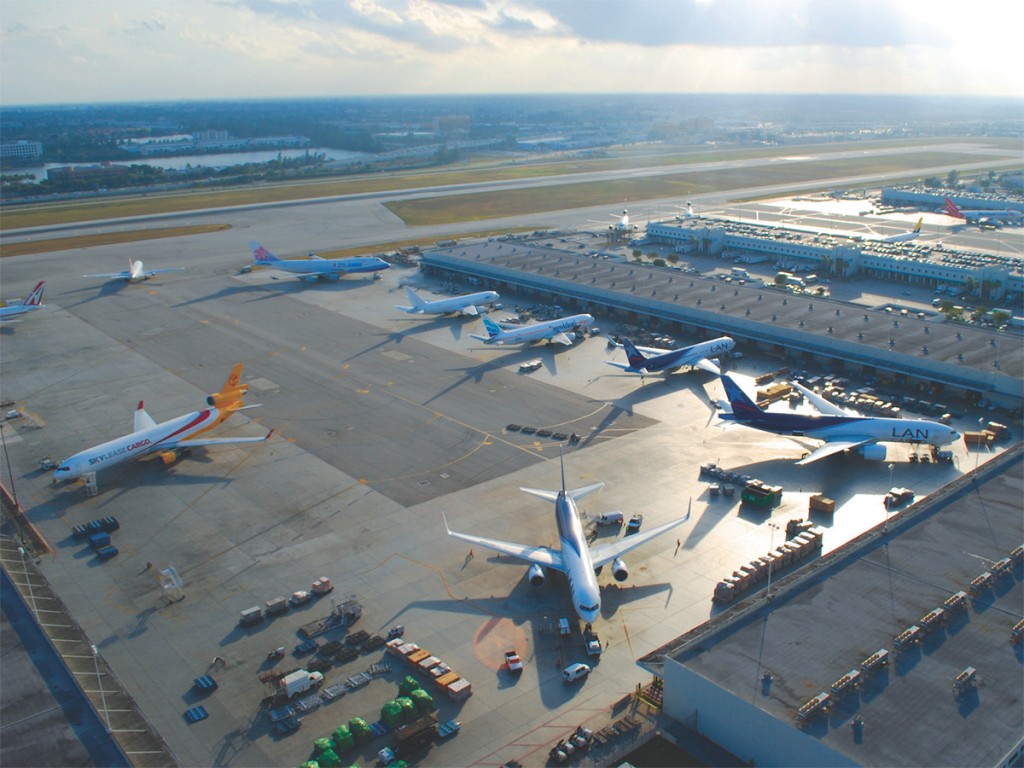Miami International Airport gateway for U.S.-Latin American trade
Miami International Airport (MIA) is the hub for Latin American and Caribbean trade with the U.S. And as the trade between the regions grows, so does the importance of Miami’s role as a logistics linchpin.

As U.S. and Latin American trade relations and volumes especially for high value goods heats up, Miami International Airport (MIA), the logistical linchpin between the two regions, plays an ever more important and strategic role in growing their economies.
“MIA, as the gateway of the Americas, continues to have more flights in Latin America—39 non-stop flights daily---than any other US airport. 15 of our top 25 international markets are in Latin America,” Ralph Cutie, director and chief executive officer of Miami International, told the American Journal of Transportation (AJOT).
The air cargo market linking the US and Latin America is served by massive belly lift capacity and Latin American freighter operators. But the dominant carrier at MIA with 150 destinations and 380 peak-day winter flights is American Airlines which uses Miami as its hub and blankets Latin American and Caribbean markets with lower deck lift capacity as well as American’s 70 US destinations. Cutie says American Air is growing its seat capacity out of MIA 10% this winter compared to winter 2002.
MIA hasn’t lost any carriers and, indeed, is adding Mexican-low-cost airline Viva Aerobus in July 2024 which will debut with three weekly flights from MIA to Monterrey and four flights weekly to Merida using A-321 and A-320 aircraft, according to Cutie. Both have narrow-body below deck cargo capacity.

Miami “Marshalling” Center For Latin American and Caribbean Freight
But MIA is more than just the largest US international cargo gateway, stresses Gary Goldfarb, director of strategy at the Miami office of Interport Group Companies, a supply chain management, foreign trade zone and Customs bonded warehousing developer. A past chairman of the powerful and prominent Miami-Dade Beacon Council, the region’s economy watchdog, Goldfarb tracks the local logistical economic health and activities.
Miami Dade is more of a “marshalling” center for Latin America and Caribbean-cargoes. “Cargoes have to be combined with other cargoes,” he explains. “If you’re in the air conditioning business you don’t have a full container of fans. You need the fan, condensers, ducting. The only exceptions to that are Argentina and Brazil, where you have large populations. You send a full container to El Salvador, and it will probably take the locals two years to consume all the contents.”
Goldfarb says MIA is “probably the largest provider of international supply chain operations in the US. “for several reasons. “The reason Miami works is that the least expensive cost in the supply chain is the warehousing. The most expensive is trucking. Miami has 450,000 square feet of warehousing with foreign trade zone status.”
He stresses that goods from India, Europe and Asia to MIA do not have to be imported intact, but parts can be “transited” through MIA and assembled or consolidated at the gateway. For example, Interport’s facilities is seven miles from Miami International, 12 miles from Port Miami and several miles from Port Everglades. “So, as a shipper, my delivery cost to the airport or to the seaports is minimal.” Plus, he says shippers can pivot in Miami between transport modes. “If I have air cargo that suddenly has to go by ocean, I can immediately do it or vice versa. That is why Miami is such a strong gateway. We can go anywhere in the world, by air or ocean.”
In a recent interview with the AJOT, Jimmy Nares, section chief, aviation marketing, Miami Dade Aviation Department, reinforced the fact that 99 airlines operate at MIA including 56 passenger or belly cargo airlines and 43 freighter carriers. “The split between belly and freighter service at MIA is quite unique compared with the other airports,” Nares said. “More than 80% is carried by freighters and less than 20% is belly cargo. It’s the reverse at many airports.”
However, MIA, as the “main entry point for air perishables in the US, accounts for approximately two-thirds or 67% for all US air perishables imports,” he adds, noting that tenants of MIA’s cargo facilities (airlines and ground handlers) have a combination of 466,000 square feet of on-airport refrigerated coolers, more than any other US airport. Plus, the “logistics community” just off airport and the City of Doral also has “significant” refrigeration capacity.
MIA’s five busiest airlines in 2022, measured by tonnage landed, were all freighters led by Atlas Air Freight (with a total 434,345 US tons) followed by UPS, Tampa Cargo Airlines, LATAM Airlines Group and Amerijet International, according to Nares. The top five markets for perishables imports include Colombia for flowers, Chile for seafood and salmon, Ecuador for flowers, Peru for asparagus and Costa Rica for flowers and seafood.

MIA Gearing For Growth
MIA is gearing up for more growth. Nares told the AJOT in an exclusive interview that Miami-Dade County Board of County Commissioners recently adopted a capital improvement program, funding up to $6.8 billion of airport wide modernization over the next five to 15 years. “Cargo buildings at MIA will be expanded, modernized or demolished, runways will be expanded, and parking stands will be added directly accessing cargo facilities.
Additionally, MIA is working with a private sector concern to build a “vertically integrated cargo community—multi-leveled –that is expected to double” the airport’s cargo capacity. No timetable has been established for completion, he said.
Goldfarb sees a positive outlook for MIA and the thrust is the northbound perishable commodities from Latin America, which is either exported further to US, Europe, or consumed locally. “Besides residents here, remember, we also have 16 million people who embark and disembark on cruise ships annually in South Florida,” he says.
The Interport executive also cited Atlas Air with its 747 jumbo jet freighters, LATAM with its 767 freighter fleet, Avianca Cargo, COPA Cargo and belly freight operator American Airlines as hauling the lions’ share of perishables northbound to and through MIA.
Goldfarb personally sees a continued bright outlook for MIA / 2024. “The airport moved 2.75 million tons of air cargo through it in 2022. They will be about even with that number in 2023. But they are hoping to get closer to that three million ton mark in 2024” he says,
Another barometer of Miami-Dade’s economic health and MIA in specific is the South Florida labor force. Goldfarb says 450,000 people or one out of every four people in the region works in trade and logistics.
Similar Stories
BTS to will begin releasing preliminary estimates of airline passenger travel in 2025
Monthly passenger enplanement numbers are not reported by the carriers and published by BTS for the month until more than a month later. BTS developed a model, which uses a…
View Article
Ambercor Shipping participated in air charter transport from Canada to Australia
View ArticleCass Information Systems acquires AcuAudit Platform from Acuitive Solutions
Cass Information Systems, Inc. (Cass), the leading global provider of freight audit & payment solutions, has acquired AcuAudit, the premier freight audit platform for ocean and international air freight, from…
View ArticleLos Angeles Industrial CRE Market Update – 4th qtr. 2024
TEU and airfreight numbers continue to improve, but excess capacity has muted any genuine change to the state of the leasing market.
View Article
CPaT announces new major partnership with “Saudia Academy”
View Article[Freightos Weekly Update] Mexico increases trade barriers for Chinese imports
Ocean rates out of Asia overall trended up slightly to end the year, but with Lunar New Year approaching and a range of January transpacific GRIs announced, prices could face…
View ArticleGet the most up-to-date trending news!
SubscribeIndustry updates and weekly newsletter direct to your inbox!





